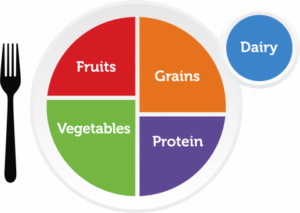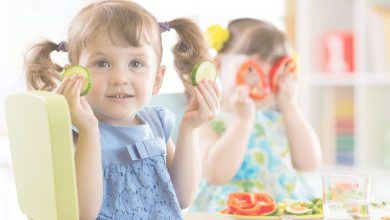Nutrition for Preschoolers

Nutrition for Preschoolers
Of all the things that parents of preschoolers can feel guilty about, eating healthy food is near the top of the list. With ever-changing guidelines and opportunities to eat poorly everywhere, it’s harder and harder for parents to keep track of what the latest guidelines are when it comes to nutrition for preschoolers. If you feel lost on what meals you should be feeding your growing preschooler, read this article to get help on what a healthy plate should look like.
What Kinds of Foods Should Preschoolers Eat
Parents may remember learning about the food pyramid when they were in school.
Well, the United States Department of Agriculture (USDA) updated that to the more fitting MyPlate symbol.

Image from https://www.myplate.gov/eat-healthy/what-is-myplate
MyPlate helps break down what should be on kids’ dinner plates. Every day is different, but MyPlate gives parents a framework on which they can build their children’s diets. The categories probably look familiar, but the ratios may look a little different. Here are the basics.
- Grains – The first food parents may think of is bread, but this category is comprised of any food made from wheat, rice, oats, cornmeal, or barley.
- Vegetables – We all know we should eat our greens, but including colorful veggies in your children’s diets is important. Make sure to add red and orange vegetables, legumes (peas and beans), and starchy vegetables.
- Fruits – Any fruit or 100% fruit juice adds to a person’s daily total. And while fresh is great, servings of canned, frozen, or dried fruit counts, too.
- Dairy – This includes milk products and foods made from milk (cheese, yogurt), as well as their fat-free, low-fat, and high-in-calcium versions. It even includes lactose-free milk and fortified soy milk and yogurts. However, it does NOT include foods made from milk that don’t have much calcium and are high in fat. (We’re looking at you, cream cheese, sour cream, and butter.)
- Protein – When it comes to meat, lean meats and poultry are best. And don’t forget about seeds, peas, and beans as excellent sources of protein.
What Does a Serving Size Look Like?
Knowing what to eat is great, but a big part of feeling overwhelmed by the topic of nutrition is knowing how much of it to consume. Practically, what does a serving for each of these food groups look like?
We’re glad you asked!
The USDA created this excellent resource for preschooler parents that breaks down food groups, serving sizes, and examples of what makes up a serving all based on age. Save it to your phone or print it off and put it on your fridge for the next time you get flustered over how many strawberries count as a serving.
Foods & Ingredients to Avoid
Now that we know what your child should eat, what should you be helping them avoid? Here are the foods the experts at Mayo Clinic say you should stay away from.
- Added Sugar – Sugar gets added to EVERYTHING. Fortunately, added sugar is a required item on every nutrition label, so it’s an easy thing to find. Avoid sodas and other drinks with added sugars, and make sure the juice you buy is 100% juice.
- Examples of added sugars: Brown sugar, corn sweetener, corn syrup, honey
- NOTE: Naturally occurring sugars like the kinds found in fruit and milk don’t count. Whew!
- Salt/Sodium – Salt is just as sneaky as sugar when it comes to being added as an unnecessary ingredient to processed foods. It can hide in bread, meat, and condiments, so an innocent looking sandwich may have more than your daily serving of salt. Check nutrition labels diligently and assume that any processed food probably has had salt added to it.
- Examples of foods high in salt: pizza, pasta dishes, soup, chips, cookies, condiments, toppings
- Saturated Fats – Saturated fats mainly come from animal sources of food. When cooking, look for ways to replace saturated fats with vegetable and nut oils, which provide essential fatty acids and vitamin E.
- Examples of foods high in saturated fat: red meats, hot dogs, butter, pizza, sandwiches, burgers, burritos, cakes, ice cream, full-fat dairy products
How Many Calories Should My Child Eat?
Your child is small, so they don’t need as many calories … but then again, they never stop moving, so maybe they need more?
Take the guesswork out of calorie counting for your preschooler by using this calorie calculator from the MyPlate website.
It’s a tool you can use for the whole family that will give you a target on how many calories each person should be eating every day. It’s that easy!
Picky Eaters
All of this information is well and good, but what do you do if you have a picky eater who doesn’t want to eat anything but white bread and potato chips?
Lucky for you, Little Sunshine’s Playhouse has an entire article written on just this topic. Take a look at our “Dealing With Picky Eaters” article and see if the information can help you turn your food critic into a food fan.
What to Do if You’re Concerned
Most parents are concerned about their child’s nutrition in one way or another. However, if you’re worried about your child taking in too many calories or too few, don’t hesitate to talk to your pediatrician or family doctor. Serious issues like childhood obesity and failure to thrive are not the norm, but they are possibilities. Don’t forget that all children go through phases where they don’t gain weight rapidly or they put on more weight than expected. Growth patterns are unique to every child, but you can verify that your kids are on the right track by talking to a doctor.
Nutrition is a hard thing to balance on a personal level, so being responsible for the nutrition of others can feel daunting. But with a little homework, some handy tools, and some self-compassion, your kids’ diets can be one less thing for you to worry (so much) about.





